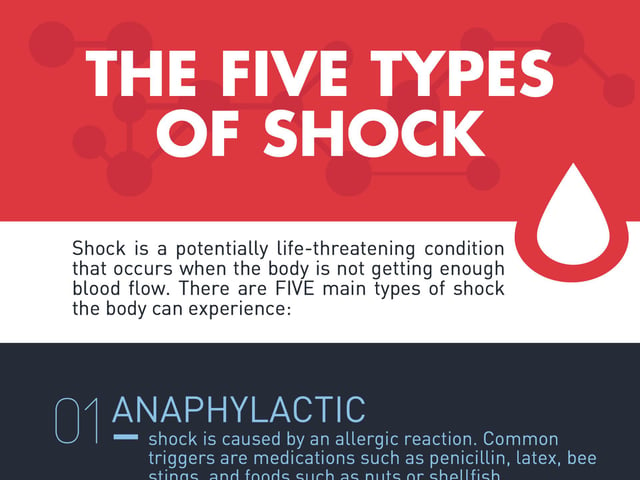
The Five Types of Shock
Shock is a potentially life-threatening condition that occurs when the body is not getting enough blood flow. There are FIVE main types of shock the body can experience:
Anaphylactic
Anaphylactic shock is caused by an allergic reaction. Common triggers are medications such as penicillin, latex, bee stings, and foods such as nuts or shellfish.
Symptoms can include decreased blood pressure, constricted airway that may impair breathing, swollen tongue or lips, tingling extremities, hives, flushed skin, confusion, and dizziness.
Treatment is typically injection with epinephrine, followed by IV cortisones and antihistamines. For breathing difficulties, supplemental oxygen or albuterol may also be administered.
Cardiogenic
Cardiogenic shock is typically caused by myocardial infarction, otherwise known as a heart attack.
Symptoms include sudden increased heart rate, difficult or rapid breathing, sweating, pale skin, and little or no urination.
Treatment is aimed at correcting the issue with the heart. Medications such as thrombolytics or blood thinners may be given, and surgery such as angioplasty, stenting, or CABG are likely.
Hypovolemic
Hypovolemic shock happens when the body loses 20% or more of its blood supply, which typically occurs through injury or accident.
Symptoms include profuse bleeding, sweating, dizziness, confusion, and rapid/shallow breathing. If the hemorrhage is internal, symptoms may also include black, tarry stools, abdominal pain, and vomiting blood.
Treatment for hypovolemic shock is aimed at stopping the source of bleeding and replacing lost fluids through the administration of IV crystalloids and blood transfusion. Drugs such as dopamine or epinephrine may also be given to increase the heart’s pumping strength.
Neurogenic
Neurogenic shock is a distributed type that typically occurs after damage to the pathways of the central nervous system, particularly to the spinal cord.
Symptoms include instantaneous low blood pressure; warm, flushed skin due to sudden vasodilation, and slowed heart rate.
Treatment typically includes medications aimed at correcting the symptoms, including vasopressin, dopamine, and atropine.
Septic
Septic shock is the result of system-wide bacterial, viral, or fungal infection, known as sepsis.
Because septic shock is directly related to sepsis, the symptoms are the same. Low urine output, confusion, cyanosis, dizziness, and respiratory problems are common. Fever, tachycardia, and tachypnea are also typically present.
Treatment is aimed at combating the underlying infection and preventing organ damage. IV antibiotics are administered, as well as vasopressors, insulin, and corticosteroids.

Keep Reading

Test of Essential Academic Skills Blog
How to Pass the TEAS Science Section
As a pivotal component of the Test of Essential Academic Skills (TEAS),…

Test of Essential Academic Skills Blog
How Long Should I Study for the TEAS Test?
According to the Bureau of Labor, there are over 3 million registered n…

Test of Essential Academic Skills Blog
Making a Studying Plan for the TEAS Exam
Are you preparing to take the ATI TEAS exam? This important test can be…